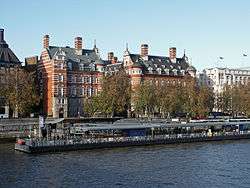Whitehall Mystery


The Whitehall Mystery is an unsolved murder that took place in London in 1888. The dismembered remains of a woman were discovered at three different sites in the centre of the city, including the future site of Scotland Yard, the police's headquarters. The incident belongs to the so called Thames Torso Murders of 1887-89.
Discovery of remains
On 2 October 1888, during construction of the Metropolitan Police's new headquarters, to be known as Scotland Yard, on the Victoria Embankment near Whitehall in Westminster, a worker found a parcel containing human remains. The female torso was discovered in a three-month-old vault that made up part of the cellar. It was placed there at some point after 29 September when Richard Lawrence, a workman, had last been inside the unlocked vault.[1] The body had been wrapped in cloth, possibly a black petticoat,[2] and tied with string.
The torso was matched by police surgeon Thomas Bond to a right arm and shoulder that had previously been discovered on the muddy shore of the River Thames in Pimlico on 11 September.[2] The Times newspaper had initially suspected that the arm was placed in the water as a medical students' prank.[2]
| Wikisource has original text related to this article: |
| Wikisource has original text related to this article: |
| Wikisource has original text related to this article: |
Speculation
Newspapers suggested a tie to Jack the Ripper's killings of prostitutes that were occurring simultaneously, but the Metropolitan Police said there was no connection. An inquest was opened by Westminster's coroner, John Troutbeck, on 8 October. It determined that the woman had been "of large stature and well-nourished", and suggested that she had been approximately 24 years old. The uterus had been removed from the body. The right arm had been severed by someone with knowledge of human anatomy, had been tourniqueted to stem blood flow, and was removed post-mortem. It was also revealed that the victim had been wearing a broché satin dress at the time of death. The dress had been manufactured in Bradford, England, from a pattern estimated as three years old. Pieces of newspaper found with the remains were from the Echo of 24 August and an issue of the Chronicle of unknown date. Although the cause of death was unknown, the victim had not suffocated or drowned; besides the uterus being absent, the left lung had severe pleurisy;[3] nothing was found to indicate that the victim had borne children; the heart was healthy and the right lung, liver, stomach, kidneys and spleen were normal. She had been dead for around six weeks to two months and had fair skin, dark hair, and was not someone who was used to manual labour.[3]
Further discovery
Later, a reporter used a Spitsbergen dog, with the permission of the police and the help of a labourer, to find a left leg cut above the knee that was buried near the construction site.[4] The head and remaining limbs were never found, and the identity of the victim remains unknown.
It has become a point of trivia and irony that Scotland Yard, one of the world's best-known police agencies, is built on a crime scene related to an unsolved murder.
Popular culture
The mystery is referenced in the third episode of the third series of Whitechapel and also in Chapter 8 of Anthony Horowitz' Sunday Times Bestseller Moriarty.